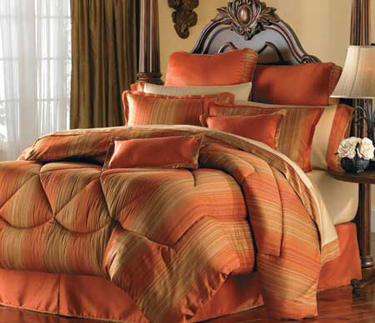
The library, once a prominent part of the institution’s name and still a prominent part of the building complex and the heart of Winterthur, has been lost in transition: Henry Francis du Pont Winterthur Museum; Winterthur Museum, Garden, & Library; Winterthur, An American Country Estate; Winterthur Museum & Country Estate.

Specially cast sewer covers bear the American Country Estate brand.


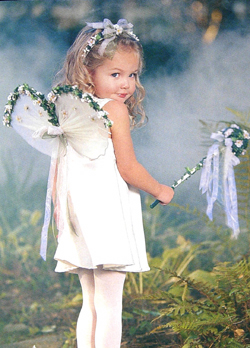

“Little girls love to play dress-up all through the year,” according to the 2001 gift catalogue. Little boys who love to dress up will have to get their fairy wings elsewhere—perhaps alighting in a Winterthur program or in a staff position.
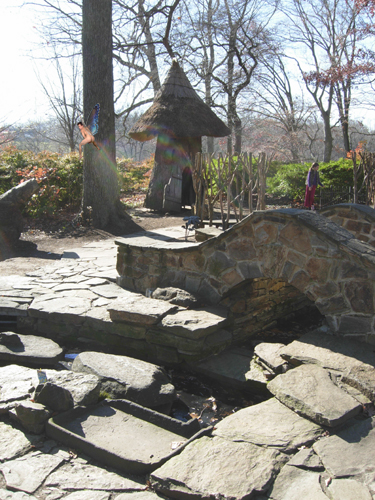
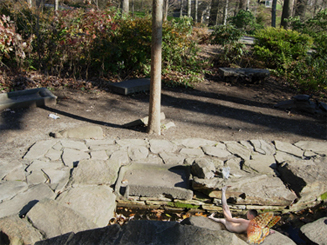


Sailors’ valentine--who knew so many have survived in such pristine condition!
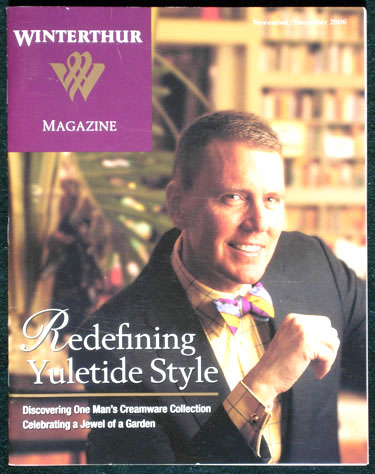
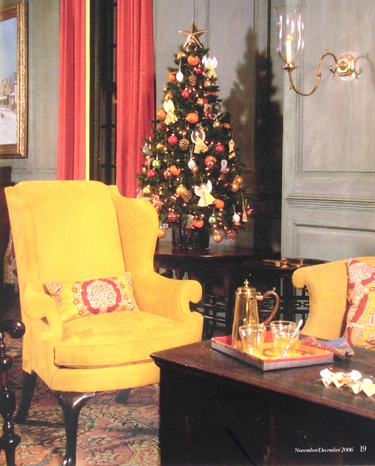
Demonstrating how the clever young homemaker might use an eighteenth-century painted chest as a serving table.
| Winterthur Magazine© instructs in “fairy code” and plugs an exhibition that “celebrates the grandeur and grace of the silver screen.” Fashion in Film is ongoing, but attendance has already surpassed that of any other exhibit since the galleries opened in 1992. This is a canned road show put together from costumes made and owned by the British costumier Cosprop Ltd. It is offered as a rental from the long list of Trust for Museum Exhibitions packages that travel to museums like the Durham Western Heritage Museum in Omaha, NE, The Society of the Four Arts in Palm Beach, FL, and the Avampato Discovery Museum in Charleston, WV. Anyone aware of Winterthur’s®©™ world renown might wonder, but such shows can be real moneymakers. Museums don’t have to spend much on development, so the 15-bucks-a-head admission fee adds up fast. Before running Winterthur®©™, Bowman directed the National Museum of Wildlife Art in Jackson Hole, WY, so she knows how to make money by pleasuring a crowd. In the magazine she redefines Winterthur’s®©™ mandate as “… our mission to inspire, enlighten, and delight our visitors.” Her statement is signed only with her carefully designed logo. As another imperious babe with a lot of fancy dresses and a cipher famously said or didn’t say, “Let them eat cake.” |
  |
|||||
The trouser fronts may be too saggy to inspire (I would have liked to see Colin Firth when “he suddenly grew into Mr. Darcy”), but the dresses in the exhibit are pretty delightful. You can actually touch strips of cheap iridescent cloth hanging on a gallery wall even though they are nothing like the extraordinarily accurate beaded and embroidered textiles used in the costumes on display. Right in the galleries is a gift shop chock full of costumey, dress-uppy, sparkly, filmy stuff you can buy. Winterthur®©™ may have a collection of period textiles, but when it comes to enlightenment, it is nothing like these! Short of meeting her in person, how else could you see just how cute ’n’ curvy Elizabeth Taylor once was? It’s no wonder there is more interest in Hollywood schmatas than in the shockingly overcleaned Rockefeller paintings that were stored on the Winterthur walls while the de Young museum in San Francisco was under construction or scuffed, scratched, and dirty Byrdcliffe Arts and Crafts furniture. Of course some shows have been based on Winterthur®©™ collections—hey, did you know they have 6,316 spoons? And don’t forget those Campbell’s™ soup tureens.

She has branded a gallery full of elegant 18th-century furniture “In Style,” appropriating the name of a supermarket-checkout fashion magazine. She has called in more troops and says her board is working on a long-term strategic plan that will continue “wowing our visitors every day” long after she’s moved on to greener pastures—with her résumé, she might well aspire to a position at the National Gallery or its partner in crime, the Wal-Mart museum. But I wonder if the wow factor will do as much for the collections as it does for Bowman’s reputation outside the Winterthur®©™ community. The Keno Brothers™ have been enlisted to put their brand of “gaga” on collections whose unique qualities could have been popularized without TV celebrity porn—Bowman wants visitors to “cavort through the galleries with Leslie and Leigh.” Will the “average citizen” be any more interested in the collections than they are now once the breathless boys leave Winterthur®©™ “hanging ten” on a technological wave?

Biltmore, built in George Vanderbilt’s lifetime, was based on European precident but by its very vastness and excess survives as a particularly American country estate.

Winterthur Cottage, where du Pont actually lived after his collections overtook the main house, has an intentionally plain exterior so as not to draw attention away from his museum. Evidence of his lifestyle did survive in the form of mostly British and European furniture, myriad sets of china with their matching embroidered table linens, and silver until 1994 when they were auctioned off in New York. Now the cottage houses the gift shop. If it were important for Winterthur to “show the visitor how to mix antiques with twenty-first-century lifestyles and tastes,” the cottage might well have served, taking wear and tear off the sacrosanct period rooms.
Web site spin: “In a single lifetime [H. F. du Pont] created an extraordinary American country estate on par with English examples that had evolved over centuries. In its heyday Winterthur had few counterparts; today it is the greatest surviving example of its kind in the nation.”
Winterthur, the museum and library, is indeed extraordinary and there is no greater example of its kind in the nation. Winterthur, the American country estate, began long before H. F. du Pont created the museum and gardens, which have little to do with English examples. One would have to be ignorant of places like Biltmore to characterize the Winterthur estate as the greatest surviving example in the nation. But of course the estate does not survive. Its heyday ended in 1951, when du Pont opened his museum to the public. I fervently hope the museum’s heyday is now and coming.
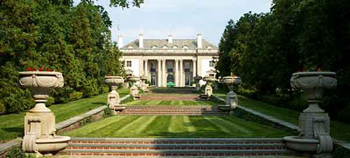
Nemours, the elaborate American country estate Alfred I. du Pont built just a few miles away from Winterthur--no research library or collection of early American decorative arts, but a lot of evidence of the fancy lifestyle favored by the du Ponts in their heyday.
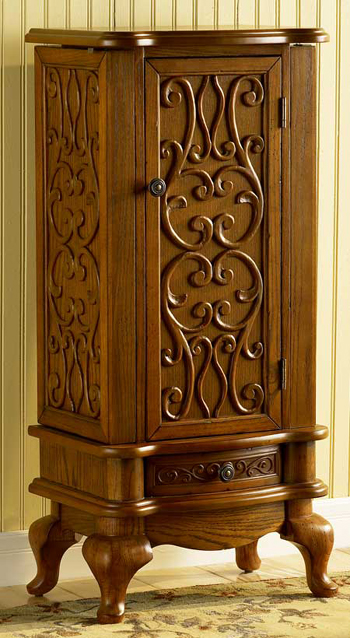
It goes on to suggest that the reader will relish the catalogue “objets d’art that echo the elegance of Winterthur. Just as H. F. du Pont relished finding items for his home, we’re sure you’ll experience the same pleasure while perusing these pages.” and “If you’re unable to [experience Winterthur firsthand,] you’ll be pleased to know our Winterthur Home catalogue offers you the next best thing: the beauty of timeless design, shipped right to your door.”
Carrying through the French theme so beloved of H. F., this “Woodland Oak Jewelry Armoire” is offered as the next best thing to Winterthur. It has curvaceous cabriole (French for curvy) legs, a bombé (French for bulging) base, and filigree appliqué (French for curly, tacked-on decoration) and is “crafted of solid hardwoods and veneers, and wood composite” (faux bois?) Surely Mrs. du Pont would have kept her jewels in something with this beauty and timeless design if only she could have!

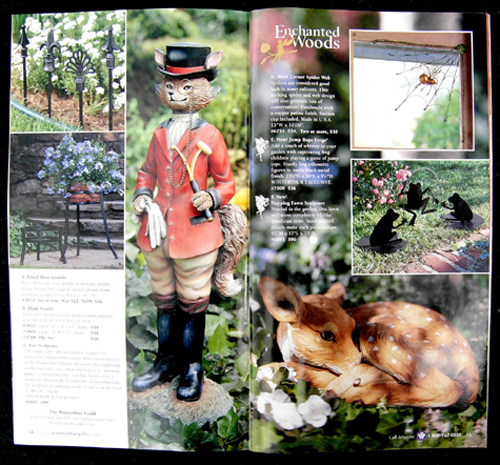
Where to start? Who did the research at the library? What is handmade about this “sculpture”? If you call it sculpture, doesn’t that make it art? If he’s wearing hunting pinks, isn’t the “gent” hunting little foxes? Isn’t that like using Big Bird to sell chicken sandwiches? I haven’t been to Leslie’s on-campus digs in quite a while (I know, I know, how could that be?) but when I was, I didn’t notice one of these in her foyer.
